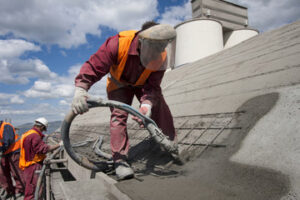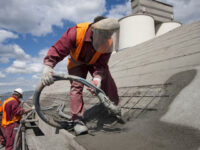How to Repair a Cracked Concrete Patio
A deteriorating concrete patio can be unsightly and dangerous. Cracks invite weeds and debris, and they create trip hazards. A patio slab without control joints will likely develop cracks over time due to shifts in the ground or freeze-thaw cycles. Control joints prevent these cracks by allowing the concrete to expand and contract without causing damage. Read on Concrete Companies Cincinnati to learn more.
 Concrete patios are a beautiful addition to any outdoor area. However, they can crack and deteriorate over time due to natural wear and tear or long-term neglect. If this happens, they can no longer serve their intended purpose and instead become an eyesore that detracts from the overall look of your garden.
Concrete patios are a beautiful addition to any outdoor area. However, they can crack and deteriorate over time due to natural wear and tear or long-term neglect. If this happens, they can no longer serve their intended purpose and instead become an eyesore that detracts from the overall look of your garden.
There are a number of ways to repair cracks in a concrete patio, including using a concrete patching material. These are typically made of epoxy or a similar substance. They can be injected into the cracks to fill them or can be applied on top of the surface. In either case, they will be much more effective at repairing the cracks than attempting to cover them up with pavers or another type of covering.
Depending on the severity of the cracks, they may be able to simply be filled with a special concrete repair compound that is designed to seal them. This is usually done by grinding the crack open and then using a special product that will bond to both sides of the crack. This will prevent water, debris and insects from making their way into the cracks where they can cause additional damage.
If the cracks are wider, a more extensive approach is required. This can involve a grinding session followed by the application of a crack filler that is typically made from polyurethane. This product will bond to the concrete and will be extremely durable. It is also possible to minimize the visual impact of these types of crack fillers by resurfacing the entire concrete patio or painting it once it is repaired.
A common cause of cracks in a concrete slab is shrinkage. This occurs when some of the moisture in the concrete evaporates during the curing process. It can also be caused by ground movement during freeze and thaw cycles. It is important to know the cause of the cracks in your concrete patio so that you can determine the best course of action for repairing them.
Spalling, which is when the concrete flakes off in thin horizontal pieces, should be patched immediately. This will prevent more spalling and is easily done with a concrete resurfacer that can be applied with a broom or squeegee.
Concrete patios are a great way to create a relaxing, safe, and fun outdoor area for families and friends. However, they can easily deteriorate over time due to natural wear and tear or long-term neglect. Luckily, there are many ways to repair them to extend their lifespan and improve the appearance of your home.
If you notice cracks in your patio, it’s important to get them repaired as soon as possible. This will prevent them from getting worse, which could lead to costly repairs in the future. Cracks that are 1/2-inch wide or less can be filled and sealed with a concrete crack filler, which you can find at any hardware store. For deeper cracks, you may need to use a caulking gun and a putty knife to force the concrete crack filler into the deep crevices.
Another common issue that homeowners experience with their concrete patios is settling slabs. This can be caused by downspouts discharging water too close to the foundation or simply by weathering over time. This is a huge safety hazard for children and pets, as well as a trip hazard for guests. The good news is that our concrete contractors can easily raise these patio slabs using Polylevel, which is injected underneath the slab to level it.
After our crew finishes the patio slab raising, we will clean up any dirt and debris that has fallen onto the newly raised area. This will make the area look better, and it will also help to keep debris from falling on other parts of your house. This will also prevent water and debris from getting into the pores of your concrete, which can cause further deterioration.
Finally, your concrete patio should be sealed to protect it from the elements and prolong its life. We recommend a penetrating concrete sealer, which will help to prevent damage from weed growth, water seepage, and freeze-thaw cycles. We can apply the sealer for you, or you can buy it at any home improvement store. Before you begin working on your concrete patio, remember to call 8-1-1, the national “Call Before You Dig” hotline, to have all underground utility lines marked for free before starting your project.
Concrete is an amazingly durable material, but it’s not maintenance-free. Over time, concrete patios crack, sink, get stained with tannin stains from twigs and leaves and can become moldy and dirty. The good news is that most of these issues can be resolved without having to replace the entire slab. If the damage is extensive, however, that might be the best option.
A concrete resurfacing mix can transform an old patio, making it look new and making the surface easier to clean. Resurfacing materials come in a variety of textures and colors, so you can choose one that complements your home. They can be applied in multiple thin coats or a single thick coat, depending on the condition of the concrete and the effect you want to achieve. A professional can do a great job resurfacing, but you can also do it yourself fairly easily.
Before applying the resurfacing material, you’ll need to clean the concrete slab thoroughly and, if necessary, etch it. Etching is a process that opens up the pores in the concrete and roughens it, allowing resurfacing material to adhere more readily. The resurfacing mix will likely float to the surface as you spread it, so it’s best to work quickly. If the concrete has a lot of pits or low spots, you can use a bull float to fill them in (Photo 7). Otherwise, just sweep the area to level it out.
Once the resurfacing material is dry, you can finish it with a nonslip texture to make the surface safer for walking. You’ll need to lightly drag a push broom across the still-wet material in one direction, and the texture will remain for several hours afterward.
When the resurfacing material is dried, you can apply a sealant to protect it from the elements. If you have expansion joints in the concrete slab, they’ll need to be sealed as well, or water that seeps through the joints will cause the concrete to deteriorate over time. You can buy a special concrete crack sealer at most hardware stores that will work well on concrete.
Concrete patios are a beautiful addition to the backyard. They’re a comfortable and inviting spot for relaxing evenings alone or hosting full-blown barbeque parties with family and friends. Unfortunately, these gorgeous backyard escapes can deteriorate over time. This is caused by a lack of maintenance, weather and other natural factors like settling and cracking. Thankfully, there are some ways to save your concrete patio and even give it a completely new look.
One way to restore a concrete patio is to clean it and protect it with a sealant. The sealer helps to prevent the concrete from becoming stained and will also make it easier to clean. The best option is to use a penetrating sealer, which doesn’t change the appearance of the patio and will not alter it in any way. If you want a more decorative touch, you can use a topical sealer instead, which is available in a wide variety of finishes and colors.
The porous surface of concrete is prone to stains, and the sooner these stains are addressed, the better. For light stains, white vinegar is an easy and practical cleaning solution. If you’re dealing with tougher stains, such as rust, it may be necessary to use a chemical cleanser. For safety, be sure to test any cleaners on an out-of-the-way area first.
Colored concrete can start to fade over time, especially in the Pacific Northwest where the sun is constantly beaming down on your concrete slab. Aside from looking dated, the faded concrete can be dangerous to walk on, which can lead to trips and falls. This is why it’s important to repair faded stamped concrete, as soon as you notice the discoloration.
Another option for restoring a faded concrete patio is to raise the surface using polyurethane. This is a fast and effective method of concrete raising that doesn’t require the removal of the existing patio, and it can even be done in one day! To learn more, check out our guide to repairing and resurfacing a concrete patio. This guide covers the basics of the process and offers step-by-step instructions that will allow you to successfully revive your patio’s appearance without having to tear it down.






